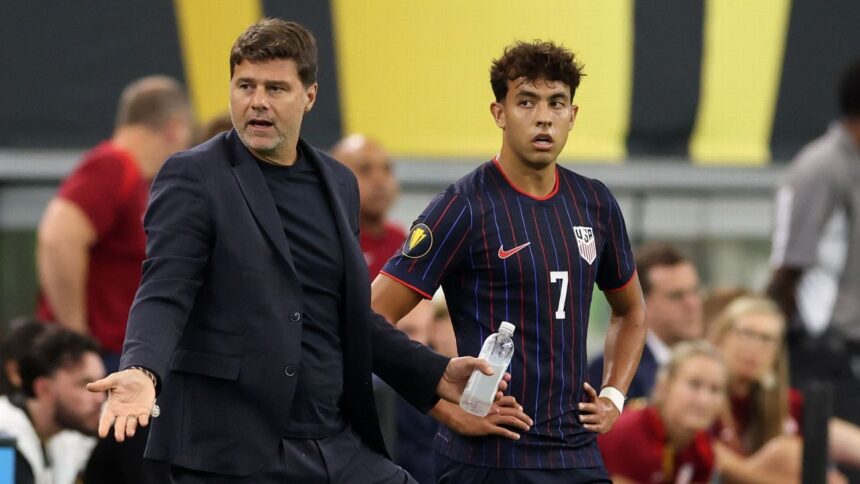The USMNT at the Crossroads: Analysis of Pochettino’s Performance and the Final Against Mexico
Let’s go back in time a little over a month. Before the controversies and provocations, before coach Mauricio Pochettino said “I am not a mannequin”, and before Christian Pulisic played golf at an inopportune moment. Let’s remember the defeat against Switzerland. Now, imagine I tell you that the United States men’s national team (USMNT) would arrive undefeated at the first five Gold Cup matches, with outstanding performances by Diego Luna and Malik Tillman, and that they would play the final against Mexico. You would probably be happy, right? And in general, many USMNT fans are happy. The team hasn’t lost, has overcome adversity, Luna has become a cult idol, and Tillman is about to join Bayer Leverkusen for a figure close to 40 million dollars. Considering that most of the starting players are not in the squad, it has been a successful summer. However, there’s something missing, both this summer and in the Pochettino era: the team still hasn’t played a good game. It has been 15 games since Pochettino took over and we still haven’t seen the USMNT overcome decent and competitive opposition in a systematic and repeatable manner. The United States has capitalized on mistakes against weak teams, struggled to score against defensive rivals, crumbled against talented opponents, and held its own against national teams that might not qualify for the next World Cup. Sunday’s final against Mexico, before a possible Mexican fanbase at Houston’s NRG Stadium, will be the most difficult match of Pochettino’s nascent tenure. It will be the last time the United States plays a competitive match before the World Cup. It will also be Pochettino’s last chance to show that his team could be heading in the right direction.Comparison of Pochettino with his predecessors
Since 2013, the USMNT has played 60 tournament matches in Concacaf, between the Nations League and the Gold Cup. This is not a perfect baseline, given the drastic difference in the quality of opponents in each match, but it’s a good way to present the average expectation for a Gold Cup or Nations League match. In these matches, according to Stats Perform data, the USMNT averages:- 2.4 non-penalty goals scored
- 0.6 goals conceded
- 14.7 shots
- 9.6 shots conceded
- 61.6% possession in the final third
- 28.9 touches in the penalty area
- 14.6 touches allowed in the penalty area
- 2.0 non-penalty goals scored
- 0.9 goals conceded
- 12.6 shots
- 8.0 shots conceded
- 63.7% possession in the final third
- 24.7 touches in the penalty area
- 15.1 touches allowed in the penalty area
Of course, some of that could be random. Perhaps this new level of territorial control is creating a more solid process, but the bounces just aren’t going the USMNT’s way. That’s possible in a sample of nine games. But that hasn’t been the case.
Contents
The final against Mexico: Significance or insignificance?
I’m not sure you need advanced statistics to understand this. In two matches against Costa Rica and Guatemala, the USMNT scored four goals and conceded three. Costa Rica is ranked 46th in the world football Elo rankings, while Guatemala is ranked 75th. Even with a US B team, you would expect more comfortable results. Mexico, for its part, occupies the 22nd position. Therefore, Sunday’s match presents a first and last for Pochettino: the last chance to win something before the World Cup, but the first time he coaches the team in a match that is not expected to win. Due to the USMNT’s reduced squad and what is expected to be a pro-Mexican fanbase in Texas, El Tri is slightly favored. According to ESPN BET’s implied odds, Mexico has a 52% chance of lifting the trophy. Strangely, it seems that everything and nothing depends on Sunday’s match. Nothing matters because this is not the team that Pochettino will take to the World Cup. Furthermore, much can and will change between now and next summer, and most of it will have nothing to do with the decisions made by anyone wearing a US Soccer jersey. But there are so few matches in international football that we have no choice but to give each match an inordinate amount of weight. Each successive match is another piece of imperfect information about the quality of the team.This is how a ranking system will also see it. According to Elo rankings, the USMNT had a rating of 1738 and a 37th position when Pochettino took over. Currently, it has a rating of 1727 and a 40th position. Teams gain and lose points every time they play a match, depending on the result, the quality of the opponent, and the level of the competition.
Therefore, if the USMNT wins on Sunday, it will progress under its new coach. If the team loses, it will take a step back. And if the match ends in a draw (and goes to penalties), the United States will stay where it is now: neither significantly better nor worse than where it was before.









